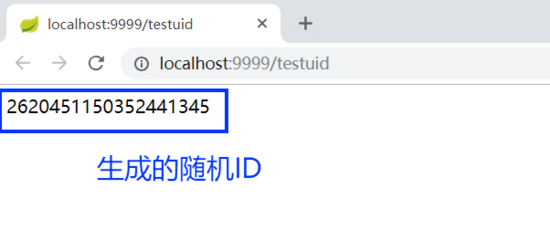spring boot中全局唯一流水号id生成器集成实验
概述
流水号生成器(全局唯一 id生成器)是服务化系统的基础设施,其在保障系统的正确运行和高可用方面发挥着重要作用。而关于流水号生成算法首屈一指的当属 snowflake 雪花算法,然而 snowflake本身很难在现实项目中直接使用,因此实际应用时需要一种可落地的方案。
uidgenerator 由百度开发,是java实现的, 基于 snowflake算法的唯一id生成器。uidgenerator以组件形式工作在应用项目中, 支持自定义workerid位数和初始化策略, 从而适用于 docker等虚拟化环境下实例自动重启、漂移等场景。
本文就在项目中来集成 uidgenerator这一工程来作为项目的全局唯一 id生成器。
本文内容脑图如下:

基础工程创建
只需创建一个 multi-moudule的 maven项目即可,然后我们集成进两个 module:
- uid-generator :源码在此
- uid-consumer :消费者( 使用uid-generator产生全局唯一的流水号 )
uid-generator 模块我就不多说了,源码拿过来即可,无需任何改动;而关于 uid-consumer 模块,先在 pom.xml中添加相关依赖如下:
|
1
2
3
4
5
6
7
8
9
10
11
12
13
14
15
16
17
18
19
20
21
22
23
24
25
26
27
28
29
30
31
32
33
34
35
|
<dependencies> <dependency> <groupid>org.springframework.boot</groupid> <artifactid>spring-boot-starter-web</artifactid> </dependency> <dependency> <groupid>org.springframework.boot</groupid> <artifactid>spring-boot-starter-test</artifactid> <scope>test</scope> </dependency> <dependency> <groupid>org.mybatis.spring.boot</groupid> <artifactid>mybatis-spring-boot-starter</artifactid> <version>1.3.2</version> </dependency> <!--for mysql--> <dependency> <groupid>mysql</groupid> <artifactid>mysql-connector-java</artifactid> <scope>runtime</scope> <version>8.0.12</version> </dependency> <!-- druid --> <dependency> <groupid>com.alibaba</groupid> <artifactid>druid-spring-boot-starter</artifactid> <version>1.1.9</version> </dependency> <!--必须放在最后--> <dependency> <groupid>cn.codesheep</groupid> <artifactid>uid-generator</artifactid> <version>1.0</version> </dependency></dependencies> |
然后在 application.properties配置文件中添加一些配置(主要是 mysql和 mybatis配置)
|
1
2
3
4
5
6
7
|
server.port=9999spring.datasource.url=jdbc:mysql://xxx.xxx.xxx.xxx:3306/xxx?useunicode=true&characterencoding=utf-8&usessl=falsespring.datasource.username=rootspring.datasource.password=xxxspring.datasource.driver-class-name=com.mysql.jdbc.drivermybatis.mapper-locations=classpath:mapper/*.xmlmybatis.configuration.map-underscore-to-camel-case=true |
完成之后工程缩影如下图所示:

下面我们来一步步集成 uidgenerator 的源码。
数据库建表
首先去 mysql数据库中建一个名为 worker_node 的数据表,其 sql如下:
|
1
2
3
4
5
6
7
8
9
10
11
12
13
|
drop table if exists worker_node;create table worker_node(id bigint not null auto_increment comment 'auto increment id',host_name varchar(64) not null comment 'host name',port varchar(64) not null comment 'port',type int not null comment 'node type: actual or container',launch_date date not null comment 'launch date',modified timestamp not null comment 'modified time',created timestamp not null comment 'created time',primary key(id)) comment='db workerid assigner for uid generator',engine = innodb; |
spring详细配置
cacheduidgenerator 配置
uidgenerator 有两个具体的实现类,分别是 defaultuidgenerator 和 cacheduidgenerator ,不过官方也推荐了对于性能比较敏感的项目应使用后者,因此本文也使用 cacheduidgenerator ,而对于 defaultuidgenerator 不做过多阐述。
我们引入 uidgenerator源码中的 cached-uid-spring.xml 文件,里面都是默认配置,我目前没有做任何修改
|
1
2
3
4
5
6
7
8
9
10
11
12
13
14
15
16
17
18
19
20
21
22
23
24
25
26
27
28
29
30
31
32
|
<?xml version="1.0" encoding="utf-8"?><beans xmlns="http://www.springframework.org/schema/beans" xmlns:xsi="http://www.w3.org/2001/xmlschema-instance" xsi:schemalocation=" http://www.springframework.org/schema/beans http://www.springframework.org/schema/beans/spring-beans-3.1.xsd"> <!-- uid generator --> <bean id="disposableworkeridassigner" class="com.baidu.fsg.uid.worker.disposableworkeridassigner" /> <bean id="cacheduidgenerator" class="com.baidu.fsg.uid.impl.cacheduidgenerator"> <property name="workeridassigner" ref="disposableworkeridassigner" /> <!-- 以下为可选配置, 如未指定将采用默认值 --> <!-- ringbuffer size扩容参数, 可提高uid生成的吞吐量. --> <!-- 默认:3, 原buffersize=8192, 扩容后buffersize= 8192 << 3 = 65536 --> <!--<property name="boostpower" value="3"></property>--> <!-- 指定何时向ringbuffer中填充uid, 取值为百分比(0, 100), 默认为50 --> <!-- 举例: buffersize=1024, paddingfactor=50 -> threshold=1024 * 50 / 100 = 512. --> <!-- 当环上可用uid数量 < 512时, 将自动对ringbuffer进行填充补全 --> <!--<property name="paddingfactor" value="50"></property>--> <!-- 另外一种ringbuffer填充时机, 在schedule线程中, 周期性检查填充 --> <!-- 默认:不配置此项, 即不实用schedule线程. 如需使用, 请指定schedule线程时间间隔, 单位:秒 --> <!--<property name="scheduleinterval" value="60"></property>--> <!-- 拒绝策略: 当环已满, 无法继续填充时 --> <!-- 默认无需指定, 将丢弃put操作, 仅日志记录. 如有特殊需求, 请实现rejectedputbufferhandler接口(支持lambda表达式) --> <!--<property name="rejectedputbufferhandler" ref="xxxxyourputrejectpolicy"></property>--> <!-- 拒绝策略: 当环已空, 无法继续获取时 --> <!-- 默认无需指定, 将记录日志, 并抛出uidgenerateexception异常. 如有特殊需求, 请实现rejectedtakebufferhandler接口(支持lambda表达式) --> <!--<property name="rejectedputbufferhandler" ref="xxxxyourputrejectpolicy"></property>--> </bean></beans> |
mybatis mapper xml 配置
即原样引入 uidgenerator源码中关于工作节点(worker node)操作的 mapper xml 文件: worker_node.xml ,其内容如下:
|
1
2
3
4
5
6
7
8
9
10
11
12
13
14
15
16
17
18
19
20
21
22
23
24
25
26
27
28
29
30
31
32
33
34
35
36
37
38
39
40
41
42
43
44
45
|
<?xml version="1.0" encoding="utf-8"?><!doctype mapper public "-//mybatis.org//dtd mapper 3.0//en" "http://mybatis.org/dtd/mybatis-3-mapper.dtd"><mapper namespace="com.baidu.fsg.uid.worker.dao.workernodedao"> <resultmap id="workernoderes" type="com.baidu.fsg.uid.worker.entity.workernodeentity"> <id column="id" jdbctype="bigint" property="id" /> <result column="host_name" jdbctype="varchar" property="hostname" /> <result column="port" jdbctype="varchar" property="port" /> <result column="type" jdbctype="integer" property="type" /> <result column="launch_date" jdbctype="date" property="launchdate" /> <result column="modified" jdbctype="timestamp" property="modified" /> <result column="created" jdbctype="timestamp" property="created" /> </resultmap> <insert id="addworkernode" usegeneratedkeys="true" keyproperty="id" parametertype="com.baidu.fsg.uid.worker.entity.workernodeentity"> insert into worker_node (host_name, port, type, launch_date, modified, created) values ( #{hostname}, #{port}, #{type}, #{launchdate}, now(), now()) </insert> <select id="getworkernodebyhostport" resultmap="workernoderes"> select id, host_name, port, type, launch_date, modified, created from worker_node where host_name = #{host} and port = #{port} </select></mapper> |
编写业务代码
config 类创建与配置
新建 uidconfig 类,为我们引入上文的 cached-uid-spring.xml 配置
|
1
2
3
4
|
@configuration@importresource(locations = { "classpath:uid/cached-uid-spring.xml" })public class uidconfig {} |
service 类创建与配置
新建 uidgenservice ,引入 uidgenerator 生成 uid的业务接口
|
1
2
3
4
5
6
7
8
9
10
|
@servicepublic class uidgenservice { @resource private uidgenerator uidgenerator; public long getuid() { return uidgenerator.getuid(); }} |
controller 创建与配置
新建 uidtestcontroller ,目的是方便我们用浏览器测试接口并观察效果:
|
1
2
3
4
5
6
7
8
9
10
11
|
@restcontrollerpublic class uidtestcontroller { @autowired private uidgenservice uidgenservice; @getmapping("/testuid") public string test() { return string.valueof( uidgenservice.getuid() ); }} |
实验测试
我们每启动一次 spring boot工程,其即会自动去 mysql数据的 worker_node 表中插入一行关于工作节点的记录,类似下图所示:

接下来我们浏览器访问:http://localhost:9999/testuid

ok,全局唯一流水号id已经成功生成并返回!
总结
以上所述是小编给大家介绍的spring boot工程集成全局唯一id生成器 uidgenerator,希望对大家有所帮助,如果大家有任何疑问请给我留言,小编会及时回复大家的。在此也非常感谢大家对服务器之家网站的支持!
原文链接:http://www.codesheep.cn/2018/10/24/springbt-uid-generator/















